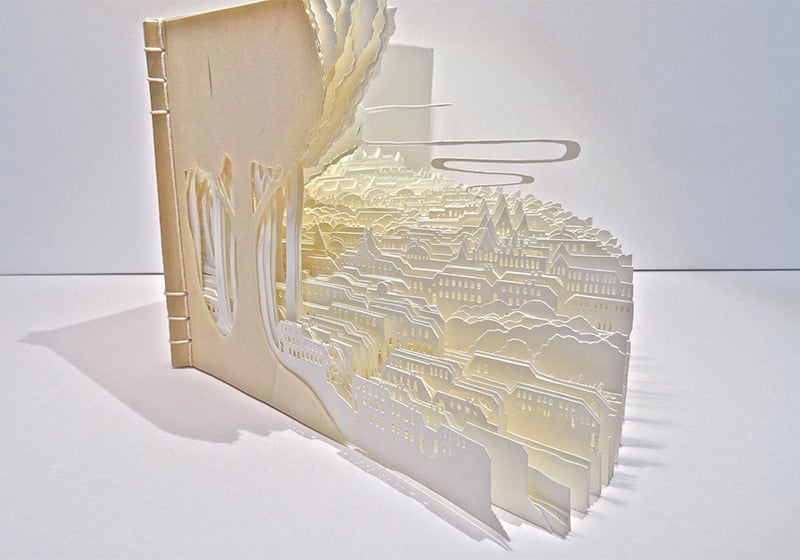Table of Contents
Ayumi Shibata is a Japanese paper artist who uses a simple technique to turn blank sheets of paper into stunning sculptures and picturesque landscapes.
She does it by cutting and layering the paper, and then using lighting to add atmosphere. Some of Shibata’s pieces are miniature landscapes that fit in the palm of your hand, others are enormous immersive installations that you can literally walk inside.
The idea for these “paper cities” came to Shibata when she was living in New York. While seeking temporary respite from the hustle and bustle of the city inside a church, she noticed its stained glass windows illuminated by natural light.

The artistic creations of Ayumi Shibata. All rights reserved.
The delicate relationship between humanity and nature
Shibata was a very curious child, and as a young girl would play with fabric offcuts and needles in her mother’s shop. Over the years, she developed an interest in papercutting. After sixth form, she moved to New York to enrol in a course on printmaking, sculpture and mixed media at the National Academy School, where she learnt more advanced techniques. In 2015, she moved again, this time to Paris.
“One day, I opened my eyes after meditation and saw colourful light flooding the floor through the stained glass. It was breathtakingly beautiful. It reminded me of a memory from childhood where I used to cut black paper and stick coloured cellophane behind it to make a ‘paper’ stained glass piece. I got the tools on my way home and tried it that night. From that moment, I continued to cut paper”, explained Shibata in a recent interview.

The artist’s main inspiration is nature; in fact, Shibata refers to her work using the term “Kami”, a Japanese word that can mean “god”, “spirit”, “divinity” and “paper”.
Kami are found in nature and in the creations of human beings. And Shibata believes they are found in paper too. Indeed, in the Shinto religion, white paper is considered as a sacred material. “‘Ya-o-yorozu no kami’ is the term we use in the Japanese language to speak of the infinite gods and spirits who live together all around the world and the universe,” she says.

The artist situates her work in a unique and distinctive cultural context by using the traditional Japanese papercutting technique, called kirigami, to depict the relationship between humans and their surrounding environment. Kirigami is a method that involves cutting and folding paper to create three-dimensional shapes, usually without using glue. Her work reminds us of the constant “dialogue” between humans and nature, and the importance of looking after the places we live.

These landscapes crafted from layers of juxtaposed white paper imagine a world in which humans and nature peacefully coexist. The light and shade are a reference to yin and yang, in other words, good and evil living side by side.
Paper represents yin, the material world, while the shadows cast by it represent yang, the invisible world: “The light represents spirit and life, how the sun rises and breathes life into the world. I believe my pieces are a place to observe the material world and the invisible one.”

A world made of paper
Shibata’s art takes us on a journey through fantastical worlds with blurred boundaries and dreamy atmospheres. World renowned in her field, she has collaborated with the likes of Christian Dior.
The landscapes she creates can be surreal, mysterious and ghostly. From time to time you can make out menacing figures among thick forests or sprawling cityscapes. Illuminated by strategically positioned lights, paper cuts interact with one another to create evocative light and shadow effects.

The white paper that Shibata uses is glossy to better reflect the lights that she judiciously positions inside her pieces. Her miniature works are also created using different cuts of overlapped paper, with the artist spending hours and hours splitting and joining different pieces of paper. Some of these creations she places inside glasses or jars illuminated by a single tiny lamp.

But what really wows are Shibata’s interactive experiences: “I cut paper to express my thankfulness to the ‘Kami’ spirits for having been born in this life. Each cut, each page is a prayer. My process helps me to be quiet and clear my mind in meditation or prayer. I purify my soul through the act of cutting paper. By interacting with the ‘Kami’ spirit material, I can connect to this spirit world with our own,” Shibata says.

The artist is living proof that you can make practically anything out of paper if you have the talent, inventiveness and work ethic. Shibata’s Japanese cultural hinterland underpins her identity as an artist. And the scale and ambition of her pieces stretch from the miniature to the massive.

The work of Ayumi Shibata is an inspiration to anyone who wants to try their hand at papercutting.

